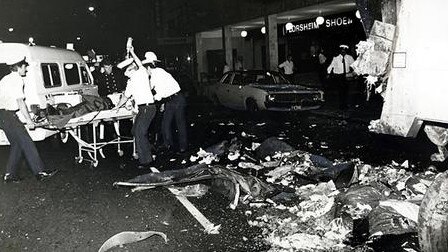Australia just spent $126m on a security review that couldn’t keep protesters off Parliament’s roof | Samantha Maiden
Anyone who works at Parliament will tell you that the joint is crawling with security upgrades of dubious usefulness, writes Samantha Maiden.

Once upon a time you didn’t even need a security pass to enter Parliament House.
The Hilton bombings changed all that.
When a bomb exploded outside the Hilton Hotel in George St, Sydney, during the Commonwealth Heads of Government Regional Meeting (CHOGRM) in 1978, then Prime Minister Malcolm Fraser called out the army.
The bomb was hidden in a rubbish bin and exploded when the bin was emptied into a garbage truck outside the hotel after midnight.
It killed two men, Alec Carter and William Favell, the garbage collectors who picked up the bin, and a police officer guarding the entrance to the hotel lounge called Paul Burmistriw, who tragically died later.
Twelve foreign leaders were staying in the hotel at the time, but none were injured.
The act of terrorism became the catalyst for the creation of the Australian Federal Police and prompted a series of changes to Commonwealth policing, intelligence and security.
In the wake of the assassination attempt on former US President Donald Trump, calls to beef up security for Australian MPs are perhaps inevitable and come from the traditional quarters.
Former Home Affairs secretary Mike Pezzullo noted there had not been a comprehensive review of protective security in Australia since Justice Robert Hope’s “groundbreaking review of 1979” after the Hilton bombing.

He raised the “rising risk of political violence, including the risk of assassination; the protective security implications of increasing violent extremism; the implications for the protection of VIPs, parliamentarians and major event security; (and) the roles and responsibilities of Commonwealth and other authorities”.
He suggested any review should examine the “protective security implications of social media – for instance, the hyper-acceleration of violent extremist messaging, and the protective security implications of disinformation and misinformation, which will increasingly inspire violent acts at a scale and at a pace that has never been seen before”.
All well and good.
But what lessons can be learned from the most recent security breaches at Parliament House involving pro-Palestinian protesters?
Seven years after a $126 million upgrade to security around Parliament House, four protestors managed to scale the building before unfurling banners above the front entrance, including one with a red triangle known for glorifying Hamas.
Speaker Milton Dick told MPs he had spoken with the AFP commissioner and had ordered an investigation into the day’s events and a wider review of security arrangements.
“I do not want a repeat of today’s events,” Mr Dick said.
But the question that needs to be asked is if $126 million won’t stop these protestors, what will? Is spending more money alone the answer?
Or do we need to spend money in a smarter, more effective manner?
Anyone who works at Parliament will tell you that the joint is crawling with security upgrades of dubious usefulness, including huge revolving barriers when you come up the stairs that have always struck many as likely to cause injury and perhaps even death if panicked crowds tried to leave the area.
You cannot run down the stairs to exit Parliament on the Senate or House of Representatives side in a hurry, unless you want to get crushed or jump over the barrier and leap around 12 feet onto concrete below.

Perhaps, we should count ourselves lucky. At one point around 10 years ago, there was a bold plan to install a giant moat around the building.
Similar embankments are commonly used by armies against tanks and would have encircled the building.
The big moat idea was ultimately abandoned in favour of a planned 2.6m fence across the front lawns.
“There were going to be big channels dug around Parliament House. They would have been vegetated,” Senator David Leyonhjelm said at the time.
“We made jokes about them being tank traps. I think the risk they were being aimed at was truck bombs.”
The recent decision of Prime Minister Anthony Albanese to effectively close his electorate office in Sydney, allowing protestors to set up camp out front, is another example of perverse outcomes.


It doesn’t affect the PM, who rarely if ever ventures into his electorate office anymore, but sends an appalling message to his constituents who now can’t access the office that taxpayers are spending millions of dollars on.
Mr Pezzullo concedes that the right balance does need to be struck.
“Politicians can’t be barricaded. I think you’re right sometimes there’s overreach and hysteria,’’ he told me this week.
But he insists that for all of the issues reviewed since 9/11, the security of MPs needs a rethink.
“What we don’t want to do is so barricade our democracy it becomes unapproachable,’’ he says.
“I am actually thinking of deeper and more worrying concerns. We’ve had drone attacks.
“An open air rally with a couple of drones dropping bombs. Do we have the counter-drone capability? Can we shoot them from the sky?
“It’s not just the obvious we’ve have to worry about but the unorthodox.”
More Coverage
Originally published as Australia just spent $126m on a security review that couldn’t keep protesters off Parliament’s roof | Samantha Maiden






